
Indiana is currently facing rising concerns about a flash drought, as dry weather patterns continue to persist across the state. This sudden and intense dry period is troubling farmers, local communities, and environmental experts alike, as it threatens crops and water supplies. Unlike traditional droughts that develop slowly, flash droughts appear quickly, leaving little time for preparation or response.
Residents and officials in Indiana are keeping a close watch on weather updates, hoping for rain to ease the situation. The fast onset of dry conditions is unusual and hard to manage, making the situation more alarming for everyone. Understanding what a flash drought means and how it could impact everyday life is important, especially for younger people who are future caretakers of the environment.
What is a Flash Drought?
A flash drought is a type of drought that develops very quickly, often within a few weeks, due to high temperatures and lack of rainfall. This rapid drying can cause serious problems for agriculture and water resources. According to the National Drought Mitigation Center, a flash drought is defined by rapid onset and intensification of drought conditions that can severely stress crops and soils.
In Indiana, the dry weather has already led to reduced soil moisture, affecting the health of fields and plants. Flash droughts are different from regular droughts which develop over months or years, making them harder to predict and manage. The quick pace at which flash droughts happen poses challenges for farmers trying to protect their crops and for communities dependent on water.
Why Indiana is at Risk Now
Several factors contribute to the flash drought concerns in Indiana at this time. The state has experienced below-average rainfall for several weeks, combined with unusually warm temperatures. These conditions cause the soil to dry out very fast. The National Weather Service reports that parts of Indiana have seen a drop in moisture levels, increasing drought risks.
Because Indiana’s economy depends heavily on agriculture, the drought worry is significant. Corn and soybean farmers are particularly vulnerable since dry conditions can lower crop yields. Water supplies, including reservoirs and groundwater, are also strained, impacting not just farming but everyday water use for residents. The Indiana Department of Natural Resources is monitoring water conditions closely to manage resources during this dry spell.
Impact on Agriculture and Local Communities
The flash drought’s effects are already visible in many parts of Indiana. Farmers report that crops are showing signs of stress early in the growing season, which could affect the quality and quantity of the harvest. Dry soils make it difficult for young plants to take root and grow properly, leading to potential financial losses.
Local communities are also feeling the impact as water restrictions may be put in place to conserve supplies for essential use. Wildlife and natural habitats are at risk, as water bodies shrink and plants struggle to survive. The situation calls for careful water management and increased awareness among residents to reduce water waste.
What Can Indiana Residents Do?
It is important for everyone to take steps to conserve water during this flash drought period. Simple actions like fixing leaks, limiting lawn watering, and using water-efficient appliances can help reduce water use. The Indiana State Government suggests staying informed through official weather updates and drought monitoring sites.
Farmers should also consider drought-resilient farming techniques, such as mulching and crop rotation, to protect their fields. Community programs may offer resources to help manage water supply and provide support during this challenging time. Staying educated about droughts and their impacts can empower residents, especially young people, to take meaningful action.
The Role of Climate Change
Experts link the increasing frequency of flash droughts to changes in global climate patterns. Warmer temperatures lead to faster evaporation of soil moisture, increasing the likelihood of sudden droughts. Climate researchers warn that regions like Indiana might see more flash drought events in the future if climate change continues unchecked.
According to the United States Environmental Protection Agency (EPA), climate change affects weather extremes, causing both severe flooding and droughts. Understanding this connection is crucial for planning and adapting to future environmental challenges. The rise of flash droughts serves as a reminder of the urgent need for sustainable environmental practices.
Conclusion: Staying Prepared and Informed
Flash drought concerns in Indiana highlight the importance of monitoring weather patterns and managing water resources carefully. Rapidly developing drought conditions can have widespread effects on agriculture, communities, and the environment. By staying informed and adopting water-saving habits, Indiana residents can help reduce the impact of these droughts.
Young readers, especially, should pay attention to these issues because the future depends on how well we manage Earth’s natural resources today. Learning about flash droughts and climate change helps build awareness that is necessary for making smarter decisions and supporting sustainable living in Indiana and beyond.







